SAT 2016
CHAPTER 11
PRACTICE TEST 1
SAT PRACTICE TEST 1 ANSWER KEY
Section 1: Reading
1. A
2. C
3. A
4. D
5. D
6. B
7. A
8. C
9. A
10. A
11. B
12. B
13. D
14. C
15. B
16. D
17. C
18. A
19. D
20. A
21. C
22. B
23. C
24. A
25. D
26. D
27. C
28. B
29. B
30. B
31. D
32. B
33. B
34. A
35. D
36. A
37. A
38. C
39. A
40. C
41. D
42. A
43. C
44. D
45. C
46. C
47. D
48. C
49. A
50. C
51. D
52. A
Total Reading Points (Section 1)
Section 2: Writing and Language
1. C
2. A
3. B
4. B
5. B
6. A
7. D
8. C
9. A
10. B
11. A
12. C
13. A
14. B
15. A
16. B
17. D
18. C
19. D
20. B
21. B
22. B
23. D
24. A
25. D
26. C
27. B
28. B
29. C
30. D
31. A
32. A
33. D
34. D
35. A
36. C
37. C
38. D
39. A
40. C
41. A
42. C
43. B
44. B
Total Writing and Language Points (Section 2)
Section 3: Math (No Calculator)
1. D
2. A
3. C
4. A
5. C
6. B
7. A
8. B
9. C
10. A
11. A
12. B
13. C
14. D
15. B
16. 4.5 or 9/2
17. 7
18. 8.4 or 42/5
19. 5 or 7
20. 8/13 or .615
Total Math Points (Section 3)
Section 4: Math (Calculator)
1. D
2. A
3. C
4. B
5. C
6. A
7. A
8. C
9. C
10. D
11. D
12. D
13. B
14. D
15. B
16. A
17. A
18. D
19. A
20. C
21. B
22. D
23. B
24. C
25. D
26. D
27. C
28. B
29. C
30. C
31. 0.8 or 4/5
32. 8
33. .96
34. 4.29 ≤ x ≤ 4.79
35. .84
36. 12
37. 371
38. 25
Total Math Points (Section 4)
SCORE CONVERSION TABLE
Scoring Your Test
1. Use the answer key to mark your responses on each section.
2. Total the number of correct responses for each section:

3. Add the raw scores for sections 3 and 4. This is your Math Raw Score: ____________
4. Use the Table 1 to calculate your Scaled Test and Section Scores (10–40).

5. Add the Reading Test Scaled Score and the Writing and Language Test Scaled Score and multiply this sum by 10 to get your Reading and Writing Test Section Score (20–80).

Table 1: Scaled Section and Test Scores (10–40)
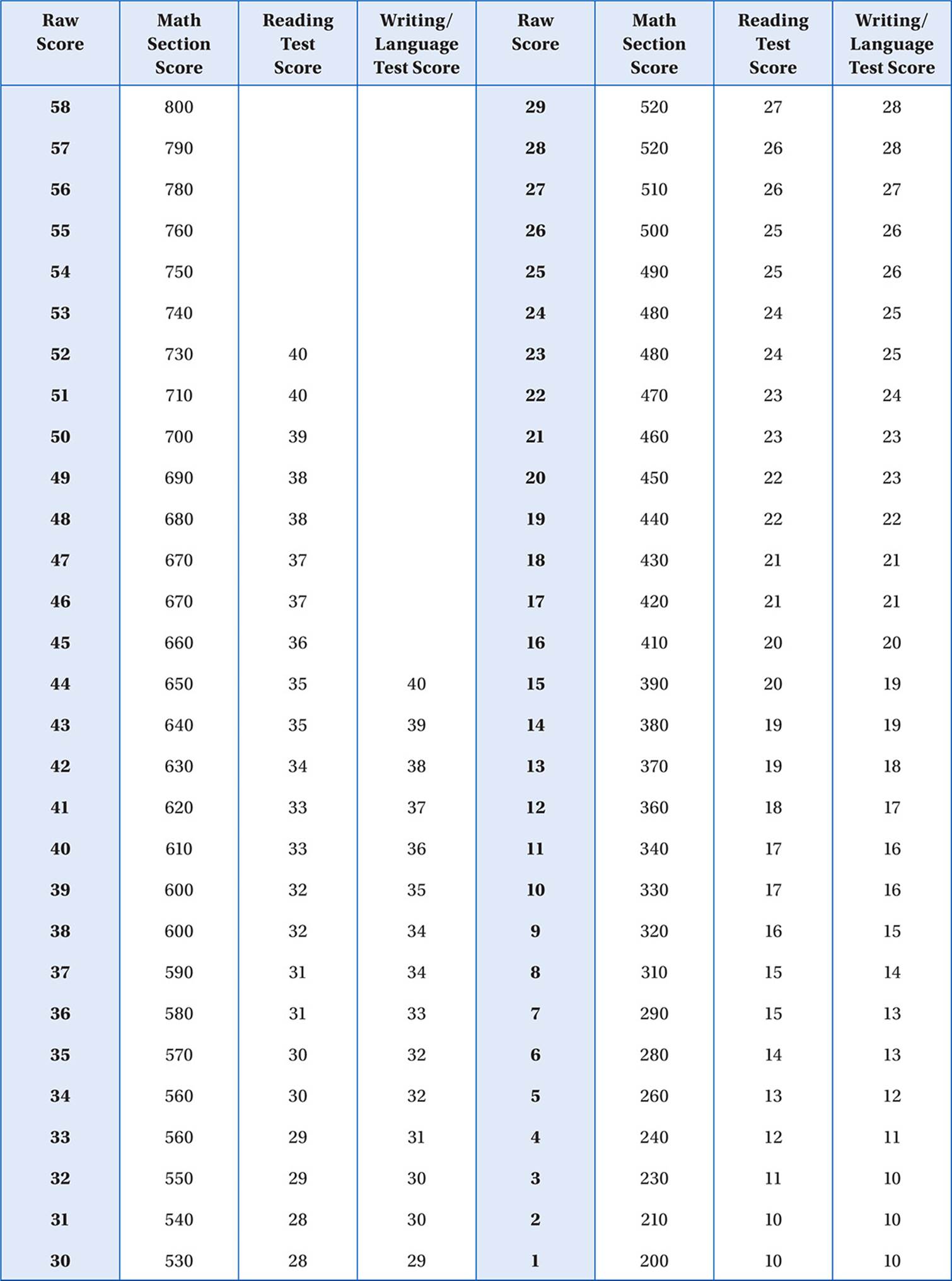
SAT PRACTICE TEST 1 DETAILED ANSWER KEY
Section 1: Reading
1. A
Detail
In lines 10–25, the author of Passage 1 discusses how farm subsidies are used both to lower food prices (by subsidizing farmers) when prices get too high, and to raise them (by paying farmers to leave their land fallow) when prices get too low. Although he disputes that these efforts to stabilize prices are worth the cost, he does indicate that they work. In the first paragraph of Passage 2 (lines 60–73), the author indicates that farm subsidies protect consumers from price spikes (lines 69–70).
2. C
Interpretation
In the first paragraph of Passage 1, the statement that something is rotten down on the farm (line 1) introduces the author’s discussion of the U.S. farm subsidies program, which he claims gives away millions of taxpayer dollars to farmers who are actually ineligible for the program (lines 6–8) and is rife with inefficiencies (line 16).
3. A
Cross-Textual Inference
The thesis of Passage 2 is that U.S. farm subsidies are vital (line 61) to both farmers and American consumers. Therefore, he regards the taxes (line 15) we pay for these subsidies to be a worthwhile expenditure.
4. D
Inference
In lines 8–9, the author of Passage 1 states that the report about corruption and incompetence in the U.S. farm subsidies program should horrify lawmakers, but it probably won’t. He explains why in the last paragraph (lines 51–59): Rich corporate farmers are an enormously powerful lobby in American politics, contributing nearly $100 million into political campaigns every year.
5. D
Textual Evidence
As the explanation to question 4 explains, the evidence for this answer is found in the last paragraph, particularly lines 53–55.
6. B
Passage Comparison
Although the author of Passage 1 does not think that the stabilization of commodity prices is worth the cost of higher taxes (lines 19–25), the author of Passage 2 indicates that price spikes (line 69) can be devastating to both farmers and consumers.
7. A
Specific Purpose
The 2009 poll cited in lines 40–43 indicates that most Americans support farm subsidies for small family farms, confirming the author’s statement that Americans feel that we need these subsidies to save the small family farmer. Choice (B) is incorrect because, although the author himself goes on to refute this misconception, the results of the poll do not. Rather, they confirm a general sentiment. Choice (C) is incorrect because the poll does not indicate any shift away from the discussion about the ineffectiveness of the U.S. farm subsidies program. Choice (D) is incorrect because the word Indeed (line 40) indicates that this result is unsurprising to him.
8. C
Data Analysis
The thesis of Passage 1 is that something is rotten down on the farm (line 1), namely, the fact that, in a recent seven-year period, the U.S. Congress has doled out more than $114 billion to farmers (lines 10–11) through a program that uses administrators who are ill-trained and poorly monitored (lines 5–6) and that implements programs that are not worthwhile to taxpayers, that are actually harming American exporters (lines 33–34) and that make it much harder for the small family farmers to compete (lines 47–48). The graph in Figure 1, however, shows about a 40% decline in these subsidies from 2000 to 2012, perhaps undercutting the author’s claim that these subsidies are an overall burden on the American taxpayer.
He would most likely, then, choose to focus on the component of these subsidies that has grown significantly in the 15 years indicated on this graph, namely, crop insurance subsidies, which have expanded at a fairly steady rate and grew by about 500% from 1998 to 2012. As the introduction to the passage indicates, this program takes money from taxpayers to help farmers to buy crop insurance, thereby providing direct entitlements not only to farmers but also to insurance companies.
Choice (A), the general decline in total farm subsidies from 2005 to 2012, does not help the author make the point that these subsidies are a burden to American taxpayers. Similarly, choice (B), the overall rate of change in commodity subsidies from 1998 to 2012 does not help his thesis, because after the first several years, the trend is generally downward. Choice (D), the sudden spike in disaster subsidies from 2004 to 2005, also does not support his thesis, because he does not make any particular claims about the benefit of disaster subsidies.
9. A
Data Analysis
The thesis of Passage 2 is that farm subsidies in the United States are vital (line 61) and not as burdensome to American taxpayers as the critics claim (lines 62–63). Therefore, the author of Passage 2 would most likely cite evidence that the total cost of the subsidies program is declining.
10. A
Cross-Textual Inference
The author of Passage 1 indicates that we taxpayers will pay more in taxes than we will ever get back in lower corn or wheat prices (lines 16–18), thereby indicating that the benefit of lower prices (line 85) is offset by its costs.
11. B
Cross-Textual Comparison
The author of Passage 1 mentions that the U.S. farm subsidy programs use administrators who give away millions of taxpayer dollars to farmers who are actually ineligible for the program (lines 6–8) and are rife with inefficiencies (line 16) to make the argument that they are not worthwhile to taxpayers. This is an appeal to the reader’s distaste for ineptitude (incompetence).
Although this could also be seen as an appeal to the reader’s fiscal prudence (sense of responsibility), the author of Passage 2 makes the same kind of appeal when he indicates that these subsidies are vital (line 61) to preventing price spikes (line 69) and are not as burdensome to American taxpayers as the critics claim (lines 62–63). Since the question asks us to find an appeal that is NOT also found in Passage 2, choice (D) is incorrect.
12. B
Interpretation
When the author of Passage 1 states that Agribusiness and farm insurance lobbies pump nearly $100 million into political campaigns every year, and the floodgates show no sign of closing (lines 53–55), he suggests that there seem to be no controls against this unscrupulous (unethical)funding of political campaigns by those who benefit from the decisions of those politicians.
13. D
Tone and Characterization
The narrator says that Reverend Jansen bent down in a cloud of Aqua Velva (lines 5–6) and told her not to worry (line 12). He then describes to the narrator why God called [her] Korean parents home (line 13). All of these descriptions work together to portray someone who is acting in a condescending and patronizing manner to a young child.
14. C
Interpretation
The statement that the narrator’s mother had been murdered (line 2) is later explained to refer to the narrator’s interpretation of the fact that she was told that “God called [her] Korean parents home” (line 13) and that “It was all part of His plan” (line 18), in other words, her death was deliberate. At first, choice (D) may seem plausible, because in lines 36–43, Sarah’s mother does not want to talk about Sarah’s biological mother. However, the passage makes it clear that the narrator attributed the “murder” to a divine plan (God kills, I thought then, line 27) rather than to any intention of her adoptive family.
15. B
Tone and Diction
The description of Reverend Jansen’s eyes and breath in lines 13–17 indicates that he is somewhat emotionally detached (his eyes sliding sideways, lines 15–16) and that Sarah is likewise emotionally detached from him and his profound claims, instead distracted by his breath that smelled vaguely of toast (lines 16–17). These descriptions surprise us, because they are so incongruent with the expectation of respect for and contemplation of the reverend’s deep spiritual pronouncements.
16. D
Interpretation
The narrator has Korean heritage, yet she grew up in a house in which Korea had always been the oddly charged word, never to be mentioned in connection with [Sarah], the same way [they] never said “Uncle Henry” and “alcoholic” in the same sentence (lines 44–47). The narrator’s mother, Christine, thought [Sarah] needed to protected from (line 49) her ethnicity. In other words, she regarded Sarah’s ethnicity as an unfortunate fact.
17. C
Textual Evidence
As the explanation to question 16 makes clear, the best evidence for the previous answer is in lines 48–52.
18. A
Literary Device
The contrast between murder and Christmas and the Easter Bunny (line 28) is a classic example of juxtaposition, the act of placing together two images with highly contrasting effects.
19. D
Interpretation
The paragraph states that Christine begins her reply patiently (line 36), which might suggest that she is demonstrating motherly sympathy. However, sympathy means “a feeling of common understanding,” and the rest of Christine’s reply suggests that she is disappointed (line 43) with Sarah rather than sympathetic with her. The point of the paragraph is that Christine is not emotionally ready (it makes me sad, line 40) to discuss something that her eight-year-old adopted daughter clearly wants to discuss, that is, she is emotionally immature.
20. A
Word in Context
When the narrator states that Korea was the oddly charged word (lines 44–45), she means that it was a word that was never to be mentioned (lines 45–46), because it was associated with potentially negative feelings. That is, it was an emotionally loaded word.
21. C
Interpretation
In lines 44–60, the narrator describes her Uncle Henry as an “alcoholic” (line 47) who sat drinking at family cookouts at the far corner of our yard, away from everyone (line 60). This is treatment appropriate to a pitiable embarrassment rather than a stern patriarch or noble hero. There is also no indication, despite Sarah’s parents’ discomfort with discussing her heritage, that Uncle Henry is a bigoted lout.
22. B
Tone and Inference
The reference to Bryant Gumbel’s cheery smirk (line 81) follows the description of his television segment during the Olympic games about how Korea had become one of the economic miracle countries (line 74). According to the narrator, the cheery smirk seemed to say Top that, Singapore! thereby indicating that he admired Korea’s ability to compete economically with other strong countries.
23. C
General Purpose
The passage as a whole describes the spectacular cyclorama (line 9) that is known as the cosmic microwave background (CMB) radiation, a 13 billion year-old panoramic snapshot of the universe as it appeared the moment it first released its primordial photons (lines 14–18). It then goes on to discuss the precise measurements that scientists have taken of this radiation and what they tell us about the early universe. In other words, the passage as a whole is discussing the analysis and significance of a cosmological phenomenon.
24. A
Specific Purpose
The description of the Gettysburg Cyclorama in the first paragraph is used to draw an analogy between two cataclysmic historical event[s] (lines 9–10), one of which we can see with our own eyes and one of which we can only detect with special tools. The answer is not (B), because although this Cyclorama depicts a historic battle, it is not itself a historical precedent (an event that serves as a model for future similar events). Choice (C) is incorrect because the painting is depicted neither as quaint nor anachronistic (out of historical order). Choice (D) is incorrect because although the passage later indicates that the discovery of the CMB was somewhat accidental, the Cyclorama was not.
25. D
Interpretation
The author indicates that to appreciate [the] full splendor[of the Cosmic Background Radiation], you would have to be able to see microwaves (lines 11–13). In other words, the disappointment is in the fact that we can’t see the spectacular cyclorama (line 8) that is the cosmic microwave background; it is an inaccessible phenomenon, at least to our naked eyes.
26. D
Specific Purpose
The discussion in lines 23–28 concerns the emergence of the first photons (light particles) in the early universe. In saying that the universe was “invisible” (lines 25–26), the author means that photons—the particles that are required for us to be able to detect something visually—did not yet exist. Calling the early universe “invisible” is somewhat inappropriate, since there were no eyes to see it anyway during that stage in its development, so the quotes are drawing attention to the fact that these terms are being used to make a technical point a bit clearer by using common words that correspond with our everyday experience.
27. C
Interpretation
The moment a swaddled one-day-old opens its eyes (lines 22–23) refers to the moment [the early universe] first released its primordial photons (lines 17–18) which we now refer to as the cosmic microwave background radiation. The discussion in the next paragraph (lines 24–36) explains that these early photons were previously trapped in an opaque fog of hydrogen plasma (line 29). Choices (A) and (D) are incorrect because this moment describes when the photons were released, not when they were first discovered by humans. Choice (B) is incorrect because these particles, as it is explained in the third paragraph, were released 380,000 years after the Big Bang.
28. B
Word in Context
The distinctive spectrum (line 64) refers to the precise “blackbody” curve for 2.75° Kelvin as shown in Figure 1. It is the particular set of wavelength intensities that distinguish blackbody radiation from ordinary radiation, and confirm Gamow’s theory about the origin of the signals detected at Murray Hill.
29. B
Inference
The passage states that Penzias and Wilson were initially troubled (line 71) by the signals that turned out to be from the CMB radiation, and in fact mistakenly attributed them to pigeon droppings (lines 74–75). This indicates that they were not looking for these signals, nor did they know how to interpret them. The work they did to receive the Nobel prize, therefore, was the result of an accidental discovery.
30. B
General Structure
As the explanation of question 29 indicates, lines 72–75 indicate that Penzias and Wilson did not understand the nature of the signals they were receiving, atttributing them erroneously to pigeon droppings.
31. D
Data Analysis
Figure 1 shows the blackbody spectrum for various temperatures, and compares these to the measurements taken of the cosmic microwave background, showing that the CMB radiation has a nearly perfect blackbody spectrum.
32. B
Word in Context
Figure 2 shows a panoramic map of the cosmic background radiation, showing that it did not originate from just one point in space, but rather from every direction.
33. B
General Purpose
The first paragraph states that the people have a right . . . to that most dreaded and envied kind of knowledge of the characters and conduct of their rulers (lines 5–9). In other words, they have the right to learn about who their leaders are and what they do. Choice (A) is incorrect because the right to pursue academic interests is discussed somewhat in the second paragraph (Let us dare to read, think, speak, and write, line 33) but not in the first. Choice (C) is incorrect, because although Adams says that the art of printing should be encouraged (line 28), this is not the primary point of the paragraph. Rather, it is secondary to the point that citizens should be well informed. Choice (D) is incorrect because although the first passage mentions the right of citizens to revoke the authority (line 13) of their leaders, it does not discuss the right of citizens to propose legislation themselves.
34. A
Word in Context
The statement that the people have a right to revoke the authority that they themselves have deputed, and to constitute abler and better agents, attorneys and trustees (lines 12–15) means that the people have the right to place in power better leaders to replace those whose authority has been revoked.
35. D
Interpretation
The passage indicates that our forefathers endured physical deprivation in the form of the hunger, the nakedness, [and] the cold (line 54), political oppression in the form of domestic tyrants and usurpers (lines 44–45), and arduous physical labor in the form of the severe labors of clearing their grounds, building their houses, [and] raising their provisions (lines 55–57). It does not mention, however, that they endured any feelings of despair. In fact, it says that they endured these with the hopes and expectations which constantly supported and carried them through all hardships with patience and resignation (lines 60–63).
36. A
Interpretation
The very first sentence states that all people have a desire to know (line 5), that is, a curious nature. Choice (B) is incorrect, because although the passage discusses at length the people’s right to revoke the authority of those in power, it does not claim that people themselves have a desire for power. Choice (C) is incorrect, because although the passage discusses the right of the people to revoke the authority of bad rulers, and mentions the inherent rights of mankind against foreign and domestic tyrants and usurpers (lines 43–45), it does not state specifically that the people have any dread of tyranny. Choice (D) is incorrect because the passage does not discuss thrift (resourcefulness with money).
37. A
Textual Evidence
As the explanation to question 36 explains, the best evidence for the previous answer is found in the very first sentence of the passage.
38. C
Interpretation
The phrase every order and degree among the people (line 34) refers to the entire society that Adams is addressing throughout the second paragraph.
39. A
Structural Comparison
The second paragraph is characterized primarily by its use of the imperative mood: Let us dare … Let every order … Let them … Let us study … Let us read … Let us examine … These sentences therefore have a much more urgent and suggestive diction than do the sentences in the first paragraph. While the first paragraph is primarily descriptive of the rights of free citizens, the second is prescriptive of their corresponding duties.
40. C
Interpretation
When Adams says Let us examine the nature of that power (lines 50–51) he is referring to the cruel power that drove [our forefathers] from their homes (line 52), that is, the domestic tyrants (line 44) that made it difficult for them to remain in their native countries. Clearly, then power refers to a despotic (tyrannical) agent.
41. D
Interpretation
Although this paragraph does discuss the privations endured by our forefathers in the form of the hunger, the nakedness, [and]the cold (line 54) and does implicitly warn against the dangerous posed by an ignorant populace because it strongly encourages us to read, think, speak, and write(line 33), this particular sentence is referring specifically to arbitrary kings and cruel priests (line 45). So the phrase the gates of earth and hell (line 46) is referring to the brutality of oppressive leaders who persecute us in our worldly existence and about an otherworldly existence.
42. A
Purpose
The sentence Let us read and recollect and impress upon our souls the views and ends of our own more immediate forefathers in exchanging their native country for a dreary, inhospitable wilderness (lines 46–50) invites us to learn about the beliefs and motivations of our forefathers who came to America to escape oppression. In other words, Adams wants to remind the reader of the importance of liberty.
43. C
Specific Purpose
The first paragraph characterizes the Southern Ocean as a foreboding place by evoking images of its chilly current (lines 2–3), the dangerous icebergs [that] hide in its gloom (lines 4–5), and the churning swells [that] sometimes serve up freak waves that can easily flip ships (lines 5–6). Such images might be used to make a case for the improbability of Smetacek’s success or the pessimism of Smetacek’s detractors, but his portion of the passage contains no such pessimism. Rather goes on directly to explain the promise of Smetacek’s work. This description, therefore, must be regarded as emphasizing the boldness of Smetacek’s experiment.
44. D
Word in Context
The phrase the base layer of the food chain refers to plankton’s role in the global ecosystem, specifically how it serves as the foundation of the food chain.
45. C
Interpretation
Although many environmentalists may well regard fertilizer run-off from farm fields (line 23) as an unfortunate by-product of farming, or an environmental hazard, the author here presents it as supplying some of the key nutritional elements (line 21) for cyanobacteria. Therefore, it is apotential sustenance (nourishment).
46. C
Characterization and Tone
The passage as a whole characterizes Smetacek’s experiments in iron fertilization to promote oceanic cyanobacterial blooms as a demonstration of the potential for large-scale manipulation of the planetary environment (lines 94–96) to remove planet-heating CO2 from the atmosphere (lines 29–30). Therefore, according to the author, this fertilization is a promising and feasible solution to a global problem.
47. D
Textual Evidence
As the explanation to question 46 explains, the best evidence for this answer is found in lines 94–96.
48. C
Data Analysis
Figure 1 depicts a satellite image of the largest recorded natural phytoplankton bloom in February 2012, believed to have been caused by the addition of iron dust blown into the sea around Antarctica by strong offshore winds (from the caption beneath Figure 1). Choice (A) cannot be correct, because Smetacek’s experiment took place in 2004, not 2012. Choice (B) cannot be correct, because the figure does not indicate anything about the relationship between algal bloom size and time of year. Choice (D) cannot be correct, because the figure does not contain any information about the relationship between bloom size and distance from the Antarctic ice shelves. The correct answer is (C) because the figure clearly shows a bloom that is well over 5,000 square kilometers (over 100 km long and over 50 km wide) in area, which is more than 30 times larger than Smetacek’s 167 square kilometer (line 53) bloom.
49. A
Inference
According to the passage, Smetacek’s theory was that iron fertilization of plankton could siphon more and more planet-heating CO2 from the atmosphere (lines 29–30) and then sequester as much as one billion metric tons of carbon dioxide annually, keeping it deep in the ocean for centuries(lines 34–37) by [dying] and [sinking] to the sea floor, thereby providing natural carbon sequestration (lines 49–50). Therefore, the death of the algal bloom described in lines 61–65 is vindication of his theory that iron fertilization can lead to carbon sequestration.
50. C
Inference
The passage states that plankton serves as the base layer of the global food chain (line 13) and therefore fertilizing phytoplankton with iron would promote blooms to help sea life thrive all the way up the food chain, even to whale populations (lines 44–46). Therefore, iron fertilization helps the whale population by supporting an important food source for the whales.
51. D
Interpretation
The second to last paragraph (lines 88–92) discusses a way to motivate further research into iron fertilization (lines 89–90) therefore the route to broader acceptance of the practice (lines 91–92) is a mode of persuasion. Choice (A) is incorrect because, although the research itself probably involves an experimental procedure, the route is not part of the research itself, but rather a means to gain support for that research. Choice (B) is incorrect because, although an appeal to the needs of commerce (line 88) shows an appreciation for economic concerns, the route is not itself aneconomic difficulty. Choice (C) is incorrect because appealing to the needs of commerce is not an idealistic approach, but rather a pragmatic one.
52. A
Tone
The last paragraph is sanguine (hopeful) about the potential for iron fertilization of the oceans to undo a great deal of the damage we have already done (lines 98–99).
Section 2: Writing and Language
1. C
Idiom
Although gerunds like hiking are often interchangeable with infinitives like to hike (for instance, saying I like hiking is essentially the same as saying I like to hike), often the conventions of idiom dictate a preference for one form over the other in a particular context. In this case, the phrasegetting students to respond is proper idiom, whereas getting students responding is not proper idiom. Choice (B) uses an infinitive form, but the phrase to become responsive inappropriately changes the meaning of the sentence.
2. A
Subject-Verb Agreement
The subject-verb core of this clause is explaining … is. Notice that this subject and verb agree in number, whereas choices (B) and (D) would introduce subject-verb disagreement. Choice (C) is not idiomatic, so the original phrasing is best.
3. B
Coordination
The original phrasing misuses the colon, which should be used only to precede an explanatory clause or an explanatory list. Choice (C) is incorrect for the same reason. Choice (D) is incorrect because it commits a number shift: choosing between punishment and incentive is choosing a single motivator, not motivators. Choice (B) avoids these errors and conveys the idea clearly and concisely.
4. B
Parallelism/Logical Comparison
The phrase better than signals that this sentence is making a comparison, which must be both parallel and logical. In the original phrasing, to reward (infinitive) is being compared with punishment (abstract class noun), and since these are different parts of speech, it violates the law of parallelism. The only choice that provides another abstract class noun is (B) reward. Choice (C) is incorrect because rewarding is a gerund, not a class noun, and choice (D) is incorrect because a reward represents an event-instance, not a class of actions.
5. B
Modifier error/Idiom
Remember that any sentence must retain its grammatical integrity even when its modifying phrases are “trimmed” away. The phrase if not more so is an interrupting modifier, but when it is removed, the sentence reads . . . as harmful . . . than punishment, which is of course not idiomatic. The only choice that avoids this problem is choice (B).
6. A
Parallelism
This sentence contains the comparative idiom not only A but also B. When we use such idioms, we must make sure that we use the precise phrasing and that the words or phrases that replace A and B are parallel. The original phrasing is both idiomatic and parallel, because both phrases that replace A and B are prepositional phrases. Choice (B) is not parallel, and choices (C) and (D) are neither parallel nor idiomatic.
7. D
Coherence
The passage as a whole is discussing the use of rewards as a teaching tool, so the underlined sentence is important because it indicates their ineffectiveness in that role.
8. C
Dangling Participles
In the original phrasing, as well as in choices (B) and (D), the participle interpreting dangles: its subject does not match the subject of the main clause, subjects. Choice (C) does not have this problem, and conveys the idea clearly and concisely.
9. A
Diction
The original word choice is best. Choice (B) is incorrect because although the results of the study may indicate that changes be made in the classroom, the phrase have profound indications for the classroom is not idiomatic, because indicate is a transitive verb and so requires a direct object. Choice (D) has a similar problem, since the verb instigate is also a transitive verb. Choice (C) is incorrect because improvisations are performances without preparation, which studies cannot do.
10. B
Transitions
This paragraph is discussing the evidence regarding the ability of rewards to incentivize learning. This particular sentence mentions a possible interpretation of that evidence; therefore, the adverb evidently is the most logical sentence modifier. Choices (A) and (C) are incorrect because they inappropriately indicate a contrast. Choice (D) is incorrect because this point is not the last of a sequence of points.
11. A
Rhetorical Devices
The final paragraph contains a prescription (strong suggestion) in the last sentence: Teachers must be aware of their students’ need to feel independent and in control. It also contains a qualification (a statement that moderates a previous claim) in the statement it would be a mistake to conclude that all rewards are bad. Choice (B) is incorrect because the paragraph contains no quantification (numerical measurement). Choice (C) is incorrect because it provides neither anecdote (illustrative story) nor metaphor (comparison that equates to things that are not literally equivalent). Choice (D) is incorrect because the paragraph contains no irony (reversal of reader expectations) or attempts at humor.
12. C
Coordination
The original phrasing is illogical because DNA does not serve as a chemical compound, it is a chemical compound. (Although someone can both serve as a nurse and be a nurse, this is because nursing is a service. Molecules do not perform services in the way that human professionals do.) Choice (B) is incorrect because it produces a comma splice, and choice (D) is incorrect because it is needlessly wordy, and because the present progressive form is serving incorrectly implies a current action rather than a general function. Choice (C) avoids these errors and conveys the idea clearly and effectively in the form of an appositive phrase.
13. A
Punctuation/Pronoun Agreement
Since the sentence uses the em-dash (—) to introduce the list of examples, it must likewise use the em-dash to close this list. Any interrupting phrase must start and end with the same punctuation marks: either commas or em-dashes. Although choice (D) uses the em-dash, it is incorrect because the pronoun itself does not agree in number with the antecedent cell types.
14. B
Diction
Choice (B) includes an illogical use of the preposition of.
15. A
Transitions
The original phrasing is best. Choice (B) is incorrect because the sentence does not indicate any logical consequence. Choice (C) is incorrect because the sentence does not indicate any contrast. Choice (D) is incorrect because the sentence does not indicate any irony.
16. B
Diction
This sentence describes the ability of doctors to use biological information to create “personalized medicine.” One who is particularly skilled is adept. Choice (A) is incorrect because apropos means appropriate to a given situation. Choice (B) is incorrect because liable means likely orlegally responsible. Choice (D) is incorrect because the phrase essential at is neither logical nor idiomatic.
17. D
Idiom
This sentence discusses using stem cells to repair damaged organs. The most concise and idiomatic way to express this functional relationship is with the infinitive to help. Choices (A), (B), and (C) all use nonidiomatic phrases.
18. C
Logical Cohesiveness/Transitions
This paragraph discusses the task of translating vast quantities of chemical information into digital form, and indicates that good progress has been made, thanks to progress in specialized hardware and software. Therefore, the best introductory sentence is (C), which focuses on progress in the computer sciences.
19. D
Subject-Verb Agreement/Idiom
The original phrasing is incorrect because the phrase our ability in translating is not idiomatic. Choice (B) is incorrect because the verb depend does not agree in number with the subject success. Choice (C) is incorrect because the phrase the ability of our translating is illogical. Choice (D) avoids these errors and expresses the idea clearly and concisely.
20. B
Idiom/Voice/Mood
The original phrasing is not idiomatic. Choice (C) is incorrect because its use of the active voice is illogical. Choice (D) is also not idiomatic. Only choice (B) conveys the proper mood (necessity) idiomatically and concisely.
21. B
Data Analysis
Choice (A) is incorrect because the graph does not indicate anything about the reason for the declining costs in gene sequencing. Choice (B) is correct because in 2014 the actual cost per genome decoded was approximately $8,000, whereas Moore’s Law predicted a cost of over $1,000,000 in 2014. This actual cost is less than 1% of the predicted cost. Choice (C) is incorrect because the cost to decode a single genome has been under $10,000 ever since 2012. Choice (D) is incorrect because the graph makes no direct comparison of the cost of genome sequencing to that of other information-based technologies.
22. B
Dangling Participles/Verb Tense
The original phrasing is incorrect because the participle using dangles: it does not share its subject with the main clause. Choice (C) is incorrect for the same reason. Choice (D) is incorrect because, although it corrects the dangling participle, the present perfect form of the verb, have discovered, is illogical.
23. D
Diction
The original word choice is illogical since qualities are incapable of deciding anything. Choice (B) and (C) are incorrect for similar reasons: anything that arranges or regulates must have a mind and intention, which qualities lack. Choice (D) is the only reasonable choice, since qualities candetermine (that is, play a deciding role in an outcome) whether or not something is art.
24. A
Verb Aspect
The original phrasing is best. The present perfect form have developed is appropriate because the status of the notions is the consequence of how they developed over the centuries. Recall that the perfect (or consequential) aspect is used to indicate a status-as-consequence (see Chapter 4, Lesson 23).
25. D
Verb Tense
This sentence indicates a historical fact, so the simple present tense is best.
26. C
Redundancy
The original phrasing is redundant, since being conspicuous is the same thing as standing out. Choice (C) is the only one that avoids the redundancy.
27. B
Logical Cohesiveness
The paragraph is about the fact that some things in our environment stand out obviously as “art.” It would be reasonable, then, to follow this point with an explanation of why a particular object, such as a chair, qualifies as art.
28. B
Coordination
The original phrasing is incorrect because the clause that follows the semicolon is not independent, and the transitive verb said lacks a logical direct object. Choice (C) is incorrect because it creates a comma splice. Choice (D) is incorrect because the clause that follows the semicolon is not independent. Choice (B) avoids these problems.
29. C
Punctuation/Coordination/Parallelism
The original phrasing is illogical because the adverb when incorrectly implies that whether or not an object qualifies for art is a time-specific event, rather than a general criterion. Choice (B) is incorrect because it creates a non-parallel list: compels … inspiring … beautiful. Choice (D) is incorrect because it’s = it is.
30. D
Coordination/Punctuation
The sentence is a compound sentence joining a dependent clause If you have … and an independent clause you have had. … The original phrasing is incorrect because a colon should be used only to join two independent clauses in which the second explains the first. Choice (B) is incorrect because a semicolon should only be used to join independent clauses. Choice (C) is incorrect because an em dash should only be used to separate an independent clause from an interrupting modifier. Choice (D) is best because a simple comma is most effective at joining a dependent clause and an independent one.
31. A
Verb Form
The original phrasing is best. Choice (B) is incorrect because the pronoun they disagrees in number with its antecedent skill, beauty, or expression. (The conjunction or implies that only one of these serves as the subject; therefore, it is singular.) Choice (C) is incorrect because it does not coordinate with the phrase that gives. Choice (D) is incorrect because it has the disagreement problem of (B) as well as the coordination problem of (C).
32. A
Coordination
The original phrasing is best. Choice (B) is illogical. Choice (C) creates subject-verb disagreement. Choice (D) is awkward and creates an unidiomatic phrase: to make them as art.
33. D
Logical Cohesiveness
This paragraph introduces and defines the “institutional theory of art,” presumably because the author regards it as an interesting theory of aesthetics. Choice (D) is best because it poses an intriguing question that follows directly from that definition. Choices (A), (B), and (C), while true statements, are irrelevant to a discussion of this theory.
34. D
Comparative Idiom/Logical Comparison
This sentence uses the comparative idiom as strong as, so we must check that the comparison is idiomatic, parallel, and logical. The original phrasing and the phrasing in choice (B) are incorrect because they create illogical comparisons: they compare people to an impact. Choice (C) is incorrect because it is not idiomatic. Choice (D) provides an idiomatic, parallel, and logical comparison.
35. A
Coordination/Idiom
The original phrasing of the participial phrase is best: notice that the subject of the past participle born is also the subject of the main clause: Chaplin. Choices (B) and (D) are incorrect because they form comma splices. Choice (C) is incorrect because the present participle being implies that Chaplin was born at the same time that he crossed the Atlantic, which is illogical.
36. C
Logical Cohesiveness
Although this sentence introduces a true and interesting fact, it is inappropriate to this paragraph, which is about Chaplin’s impact on the film industry.
37. C
Coordination
The sentence begins with two adjectival phrases that modify the Tramp. Therefore, these modifiers will dangle unless the subject of the main clause is the Tramp. The only choice that avoids this dangling is (C).
38. D
Parallelism
The original phrasing includes a list that is not parallel: writer, director, and editing. The only choice that does not violate the Law of Parallelism is (D).
39. A
Parallelism
The original phrasing is best because it creates the parallel phrasing taking on … writing … and thus allowing.
40. C
Sentence Fragments/Comparative Idiom
The original phrasing is incorrect because it creates a sentence fragment. Choices (B) and (D) commit the same error. Only choice (D) forms a sentence with an independent clause. Note also that is correctly applies the comparative idiom not only A but also B.
41. A
Dangling Modifiers
The original phrasing is best because it coordinates with the appositive phrase that begins the sentence. Choices (B) and (C) allow this appositive to dangle. Choice (D) is incorrect because the phrase became targeted for is not idiomatic.
42. C
Logical Coordination/Idiom
This sentence describes the reason that Chaplin drew the ire of J. Edgar Hoover. Choice (C) provides the most logical phrase to coordinate this state of being and its cause: because of. The prepositional phrases in the original phrasing and in choices (B) and (D) do not convey this logical relationship.
43. B
Pronoun Agreement
The original phrasing is incorrect because the definite pronoun they disagrees in number with the antecedent government. Choice (C) is incorrect because the subjunctive form would have been incorrectly implies that this clause in counterfactual. Choice (D) is incorrect because propaganda, although it sounds plural, is singular.
44. B
Diction
In this context, eradicated does not work because it means destroy completely, as a scourge, which does not accurately modify a visa. Choice (B), revoked (officially invalidated) works nicely. Choice (C) is illogical because the visa is not disallowed entry into a group, as excluded would imply. Choice (D) is illogical because abolish more properly describes the formal termination of an institution, practice, or system.
Section 3: Math (No Calculator)
1. D
Algebra (solving equations) EASY
8x + 6 = 6m
To solve in one step, just divide both sides by 2:
4x + 3 = 3m
2. A
Algebra (linear systems) EASY
To determine which ordered pair is a solution to the system, just “plug in” the values for x and y and choose the one that satisfies both equations. Notice that x = 2 and
y = 3 is a solution because 3(2) + 4(3) = 18, and  .
.
3. C
Algebra (algebraic expressions) EASY

Distribute:

Simplify:

4. A
Advanced Mathematics (polynomials) EASY
There are several ways to approach this question. Perhaps the simplest is to use the Factor Theorem: If x − c is a factor of a polynomial, then x = c is a zero of that polynomial. Therefore, if x − 3 is a factor of our polynomial, x = 3 must be a zero:
x2 + kx + 12 = (3)2 + 3k + 12 = 0
Simplify:
9 + 3k + 12 = 0
Subtract 21:
3k = –21
Divide by 3:
k = –7
Alternately, you might try to find the other factor of the quadratic. Since the constant term in the quadratic is 12, the constant term in the other binomial factor must be 12 ÷ –3 = −4.
(x − 3)(x − 4) = x2 + kx + 12
FOIL:
x2 − 7x + 12 = x2 + kx + 12
Subtract x and 12:
–7x = kx
Divide by x:
–7 = k
5. C
Additional Topics (circles and triangles) MEDIUM
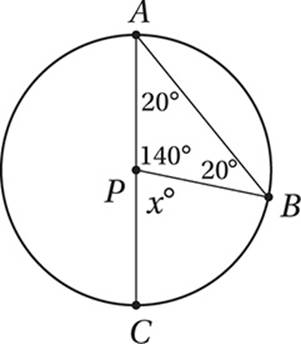
Since PA and PB are both radii of the circle, they are congruent, and so triangle APB is isosceles. By the Isosceles Triangle Theorem, then, angle A must also be 20°. From here, you might simply notice that the angle we’re looking for, CPB, is the external angle to this triangle, and so it has a measure equal to the sum of the two remote interior angles: 20° + 20° = 40°. Alternately, you could notice that angle APB must have a measure of 140° (since all angles in a triangle have a sum of 180°), and since AC is a straight line, angle CPB = 180° − 140° = 40°.
6. B
Advanced Mathematics (sequences) MEDIUM
Let’s choose a value, like b = 2, for our positive constant. This gives us an expression of 2n + 4 for the nth term of the sequence. Substituting n = 1, n = 2, n = 3, etc. gives us a sequence of 6, 8, 10, 12, 14, and so on. Choice (A) is clearly incorrect, because the first term of this sequence is not 2. Choice (C) is also incorrect because the average of the first three terms is (6 + 8 + 10)/3 = 8, not 2. Choice (D) is also incorrect because the ratio of the second term to the first is 8/6 = 4/3. Only choice (B), the difference between the fourth term and the third term, 12 – 10, gives us a value of 2.
7. A
Advanced Mathematics (radical and exponential equations) MEDIUM
For this question, we need to know two Laws of Exponentials from Chapter 9: Law #8 and Law #9. First, we use Law #9 to translate the radicals into exponents.
Given equation:
![]()
Apply Law of Exponentials #9:
![]()
Apply Law of Exponentials #9 again:

Apply Law of Exponentials #8:
![]()
Raise to the ![]() power:
power:

Apply Law of Exponentials #8 again:
![]()
8. B
Algebra (word problems) MEDIUM
Perhaps the most straightforward way to approach this question is to regard it as a conversion from a given area of lawn (in square feet) to cost (in dollars).
Area of rectangular lawn:
A = bh = ab square feet
Convert using given conversion factors:

Make sure to check this calculation by noticing that all units “cancel” as common factors, except for the unit we want, dollars, which remains in the numerator.
9. C
Advanced Mathematics (rational inequalities) MEDIUM
Original inequality:

Multiply by 3m (since m > 0, we don’t “flip” the inequality):
15 ≤ 2m
Divide by 2:
7.5 ≤ m
Therefore, the least possible value of m is 7.5.
10. A
Algebra (linear functions) MEDIUM-HARD
Given function:
f(x) = 3x + n
Substitute f(2) = 0:
f(2) = 3(2) + n = 0
Simplify:
6 + n = 0
Subtract 6:
n = –6
Therefore, the function is f(x) = 3x − 6.
Evaluate f(n):
f(n) = f(–6) = 3(–6) - 6 = –18 – 6 = –24
11. A
Algebra (absolute values) MEDIUM-HARD
First, we should notice that each choice can be interpreted as a distance between two points on the number line.
A) |s − v| = the distance between s and v
B) |s − t| = the distance between s and t
C) |s + v| = |s − (–v)| = the distance between s and –v
D) |u + v| = |u − (–v)| = the distance between u and –v
Thinking this way gives us a very straightforward way to solve the problem without doing any calculation. First we need to locate –v on the number line by just reflecting v over the origin at 0. (Recall that multiplication by –1 is equivalent to reflecting a point on the number line over the origin at 0.) This makes it easy to see the distances the problem is asking us to compare:
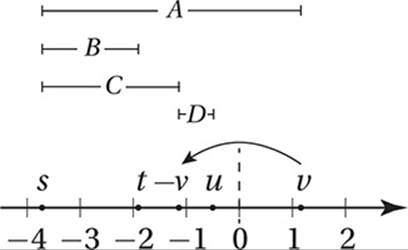
Clearly, the greatest of these distances is (A).
12. B
Special Topics (trigonometry) MEDIUM-HARD
In order to solve this without a calculator, we need to know how to analyze this problem in terms of the unit circle. First, let’s solve for cos x:
4 cos x = 1
Divide by 4:

What does the mean in terms of the unit circle? Recall from Chapter 10, Lesson 9, that the cosine of any angle corresponds to the x-coordinate of the corresponding point for that angle on the unit circle:
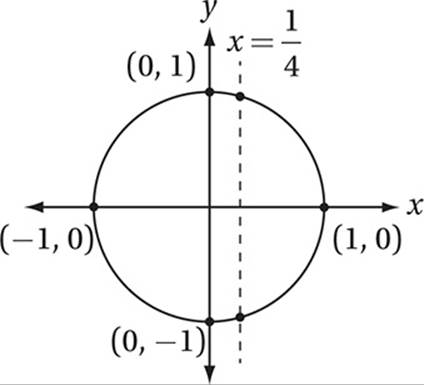
Notice that there are exactly two points on the unit circle that have an x-coordinate of 1/4. Now let’s think about the angle. We are told that x goes from 0 to 3π. Remember that a full trip around the circle is 2π radians; therefore, a journey from x = 0 to x = 3π is 1.5 trips around the circle counterclockwise starting from the positive x-axis. If you trace with your finger 1.5 times around the circle starting from the point (1, 0), you’ll hit our “points of interest” exactly three times.
13. C
Additional Topics (complex numbers) HARD
To solve this without a calculator, you must be able to evaluate a few low powers of i. Recall from Chapter 10, Lesson 10, that i0 = 1, i1 = i, i2 = –1, i3 = –i, and i4 = 1. Therefore i3 + i = –i + i = 0. Now, it’s just a matter of finding the choice that does NOT equal 0.
A) (2i)2 + 4 = –4 + 4 = 0
B) 2 – 2i4 = 2 – 2 = 0
C) 2i2 – 2 = –2 – 2 = –4
D) i4 – 1 = 1 – 1 = 0
Therefore, the correct answer is (C).
14. D
Algebra (graphs of quadratic equations) HARD
Recall from Chapter 9, Lesson 6, that any equation in the form y = a(x – h)2 + k has a vertex at (h, k) and is open up if a > 0 and down if a < 0. In the equation y = –(x + m)2 + m; therefore, the vertex is (–m, m), and a = –1. Since m > 1, this means that the vertex of the parabola has a negativex-coordinate and a positive y-coordinate, which means the vertex is in quadrant II. And since a < 0, the parabola is open down. The only graph among the choices that is an open down parabola with a vertex in the second quadrant is the graph in choice (D).
15. B
Advanced Mathematics (linear and nonlinear systems) HARD
First, notice that the question is only asking us to find values of x, so it’s a good idea to substitute in order to eliminate y from the system.
x − 3y = –2
Substitute  :
:

Multiply by x and simplify:
x2 − 15 = –2x
Add 2x:
x2 + 2x − 15 = 0
Factor using Sum-Product Method:
(x − 3)(x + 5) = 0
Therefore, the values of x that satisfy the original system also satisfy the equation
(x − 3)(x + 5) = 0.
16. 4.5 or 9/2
Algebra (linear equations) EASY
Original equation:

Substitute b = 4:

Simplify:

Subtract 2:

Multiply by ![]() :
:

17. 7
Advanced Mathematics (rational equations) EASY
Given inequality:

Multiply by 2x:
12 + 1 < 2x
Simplify:
13 < 2x
Divide by 2:
6.5 < x
The smallest integer that is greater than 6.5 is 7.
18. 8.4 or 42/5
Additional Topics (perimeters and area) MEDIUM-HARD
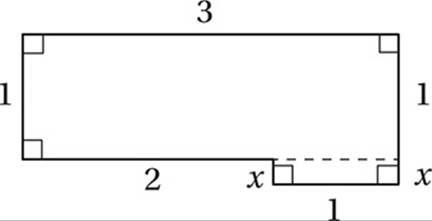
First, drawing a line as shown in the diagram shows that the figure is composed of two rectangles, but the height of the smaller one is unknown. Let’s call it x. The area of the larger rectangle is (3)(1) = 3, and the area of the smaller rectangle is (1)(x) = x. Clearly, the area of the figure must be the sum of these two areas

Subtract 3:

Therefore, the perimeter of the figure is just the sum of the lengths of its sides. If we travel around the figure clockwise from the leftmost side, we get a perimeter of
 .
.
19. 5 or 7
Algebra (rational equations) MEDIUM-HARD
Original equation:

Multiply by 4(x + 1)(x – 1):

We do this because 4(x + 1)(x – 1) is the least common multiple of the denominators, so multiplying both sides by this will eliminate the denominators and simplify the equation.
Cancel common factors:
24(x – 1) – 12(x + 1) = (x + 1)(x – 1)
Distribute and FOIL:
(24x – 24) – (12x + 12) = x2 – 1
Collect like terms:
12x – 36 = x2 – 1
Subtract 12x and add 36:
0 = x2 – 12x + 35
Factor:
0 = (x – 5)(x – 7)
Solve using Zero Product Property:
x = 5 or 7
20. 8/13 or .615
Special Topics (trigonometry) HARD
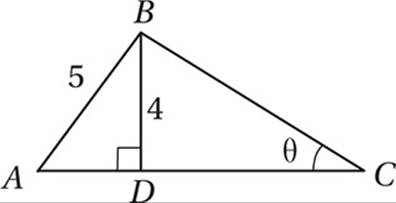
Find AD with Pythagorean Theorem:
(AD)2 + 42 = 52
Simplify:
(AD)2 + 16 = 25
Subtract 16:
(AD)2 = 9
Take square root:
AD = 3
Or, even better, just notice that triangle ADB is a 3-4-5 right triangle.
Use triangle area formula to find AC:

Simplify:
2(AC) = 19
Divide by 2:

Find DC:

Find tan θ:

Section 4: Math (Calculator)
1. D
Algebra (solving equations) EASY

Multiply by 20:
n = 0.8(20) = 16
2. A
Data Analysis (central tendency) EASY
The median of three numbers is the one in the middle when they are listed in order. If two of the numbers are 10 and 12, with 12 as the median, then the third number must be greater than or equal to 12, otherwise 12 would not be in the middle. Of the choices, only (A) 8 is not greater than or equal to 12.
3. C
Algebra/Data Analysis (expressing relationships) EASY
The first ordered pair, x = 0 and y = 2, does not satisfy the equations in (A), (B), or (D), so those choices can be eliminated. You should also confirm that the equation in (C), y = 2x + 2, is satisfied by all four ordered pairs.
4. B
Data Analysis (central tendency) EASY
Let’s call the 3 positive integers a, b, and c. If the average of these numbers is m, then

Multiply by 3:
a + b + c = 3m
New average when 24 is included in the set:

Substitute a + b + c = 3m:

5. C
Algebra (rational equations) EASY

Multiply by x:
6 + 3x = –x
Subtract 3x:
6 = –4x
Divide by –4:

6. A
Algebra (representing quantities) EASY
The cost for a month’s worth of energy is the cost per kilowatt-hour times the total number of kilowatt-hours used: ($0.15/kWh)(30 kWh). The total monthly charge, P, must also include the service fee: P = 0.15(30) + 16.
7. A
Advanced Mathematics (triangle trigonometry) EASY
Remember the definitions of the basic trigonometric functions: SOH CAH TOA. Since the “side of interest” (h) is the opposite side to the given angle (42°), and since we know the length of the hypotenuse (1,200), we should use SOH.

Plug in the values:

Substitute sin 42° = 0.669:

Multiply by 1,002:
(1,200)(0.669) = 802.8 = h
8. C
Special Topics (polygons) EASY
The sum of the measures if the interior angles of a triangle is 180°, therefore m ∠ BED + 90° + 50° = 180°, and so m ∠ BED = 40°. Since ∠ AEC is vertical to ∠ BED, it must also have a measure of 40°, and so
40 + x + x = 180
Simplify:
40 + 2x = 180
Subtract 40:
2x = 140
Divide by 2:
x = 70
9. C
Data Analysis (histogram) MEDIUM
According to the histogram, 7 students received 15 credits, 1 student received 16 credits, and 1 student received 18 credits, for a total of 9 students who received 15 or more credits. This is 9/24 of the total, or 37.5%
10. D
Data Analysis (histogram/central tendency) MEDIUM
Data set: 8, 9, 12, 12, 12, 12, 12, 12, 12, 12, 12, 12, 13, 13, 13, 15, 15, 15, 15, 15, 15, 15, 16, 18
The median of a set of numbers is the “middle” number of the set when the numbers are listed in order. If the set contains an odd number of numbers, the median is the middle number, but if the set contains an even number of numbers, it is the average of the two middle numbers. Since this set contains 24 numbers, the median is the average or the 12th and the 13th numbers. The 12th number in the set is 12, and the 13th number in the set is 13, the median is 12.5.
11. D
Algebra (absolute values) EASY
The absolute distance from a to b is |a − b| and the absolute distance from –2 to 6 is |–2 − 6| = 8. Therefore, |a − b| > 8.
12. D
Special Topics (circles) MEDIUM
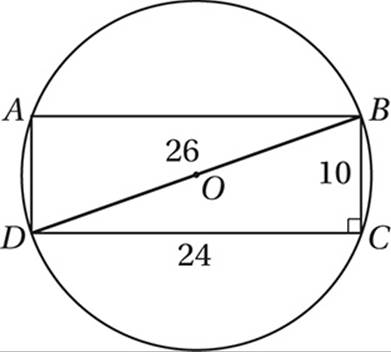
Since ABCD is a rectangle, we can find the length of its diagonal using the Pythagorean Theorem: 102 + 242 = d2. Even better, we can notice that the two legs are in a 5:12 ratio, and therefore triangle BCD is a 5-12-13 triangle. In either case, we find that DB = 26. Since DB is also a diameter of the circle, the radius of the circle is 26/2 = 13, and therefore, the area of the circle is πr2 = π(13)2 = 169π.
13. B
Problem Solving/Data Analysis (enumeration of data) MEDIUM
If Niko is the 8th oldest person in the class, then there are 7 students older than he is. If he is the 12th youngest person, then there are 11 students younger than he is. Therefore, there are 18 students in addition to him, for a total of 19 students.
14. D
Additional Topics (complex numbers) MEDIUM
(2 – i)(3 – 2i)
FOIL:
6 – 4i – 3i + 2i2
Substitute i2 = –1:
6 – 4i – 3i + 2(–1)
Combine like terms:
4 – 7i
15. B
Advanced Mathematics (exponentials) MEDIUM
f(3) = (32)–2b = 3
Exponential Law #8
(from Chapter 9, Lesson 9):
3–4b = 31
Exponential Law #10
(from Chapter 9, Lesson 9)
–4b = 1
Divide by –4:

16. A
Data Analysis (probability) MEDIUM
Since the sum of 55 and 35 is 90, which is 10 greater than 80, there must be at least 10 in the overlap between the two sets. Statement (B) is not necessarily true, because it is possible that all 35 students taking AP courses are also varsity athletes, which is more than half of 55. Statement (C) is not true because 80 – 55 = 25 students do not play varsity sports, and 80 – 35 = 45 students do not take at least one AP course. Statement (D) is not necessarily true, because 35 students take at least one AP course and 25 students do not play a varsity sport, and this sum, 35 + 25 = 60, is less than the total number of students, so it is possible that there is no overlap between these two sets.
17. A
Algebra (slopes) MEDIUM
If AB = BC, then triangle ABC is isosceles and therefore the two base angles are congruent and the triangle has a vertical axis of symmetry at the line x = 3. This implies that the slopes of lines ![]() and
and ![]() are opposites. We can calculate the slope of
are opposites. We can calculate the slope of ![]() from its endpoints:
from its endpoints:

Therefore, the slope of ![]() is 3, and so mn = (3)(–3) = –9.
is 3, and so mn = (3)(–3) = –9.
18. D
Advanced Mathematics (functions)
MEDIUM-HARD
To answer this question, we must evaluate each of the three functions for an input of ½:



Therefore,  .
.
19. A
Data Analysis (graphing data) MEDIUM-HARD
If y varies inversely as the square of x, then the variables are related by the equation  , where k is a positive constant. The graph of such an equation in the xy-plane looks like this:
, where k is a positive constant. The graph of such an equation in the xy-plane looks like this:
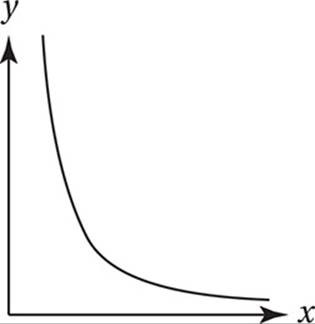
This most closely resembles the scatterplot in choice (A).
20. C
Algebra (expressing relationships) MEDIUM-HARD
The portion of the birds that are finches is just the number of finches divided by the total number of birds. Since there are already 30 finches, adding n finches makes 30 + n finches. Since there are already 12 + 30 + 18 = 60 total birds, adding n finches makes 60 + n total birds.
Since  .
.
21. B
Advanced Mathematics (functions) MEDIUM-HARD
f(x) = x2 – 1
Substitute  :
:

Simplify:

Get common denominator:

Subtract fractions:

Factor numerator:

22. D
Advanced Mathematics (quadratics)
MEDIUM-HARD
Since k can be any number greater than 0, let’s pick k = 1 for convenience. If x = 3, then y = (1)(3)2 = 9, and if x = 12, then y = (1)(12)2 = 144. In this case, both statement (B) and statement (D) are true, since 9 + 135 = 144 and 9(16) = 144; therefore, we can eliminate choices (A) and (C). Now let’s choose k = 2. If x = 3, then y = (2)(3)2 = 18, and if x = 12, then y = 2(12)2 = 288. Since 18 + 135 ≠ 288, but 18(16) = 288, the correct answer is (D).
Notice, also, that since y varies directly as the square of x, then when x is multiplied by n, y is multiplied by n2. Since x is being multiplied by 4 (to go from 3 to 12), then y must be multiplied by 42 = 16.
23. B
Advanced Mathematics (analyzing quadratics) HARD
One way to tackle this question is simply to simplify the expression for f(7), and then see which choice gives the same expression.
f(7) = k(7 + 6)(7 − 1) = k(13)(6) = 78k
Evaluate (A):
f(–78) = k(–78 + 6)(–78 − 1) = k(–72)(–79) = 5,688k
Evaluate (B):
f(–12) = k(–12 + 6)(–12 − 1) = k(–6)(–13) = 78k
Evaluate (C):
f(–2) = k(–2 + 6)(–2 − 1) = k(4)(–3) = –12k
Evaluate (D):
f(78) = k(78 + 6)(78 − 1) = k(84)(77) = 6,468k
This shows that f(–12) is equal to f(7). Alternately, you might just make a quick sketch of the parabola and take advantage of the symmetry:
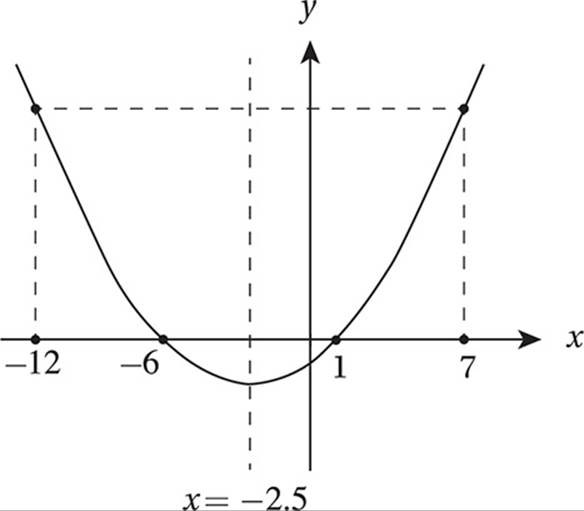
24. C
Problem Solving (percentages) MEDIUM-HARD
Let p = the initial price per share of the stock. After the first year, its price increased by 20%, so its price was (1.20)p. After the second year, this price declined 25%, so its price was (0.75)(1.20)p. After the second year, this price increased by 10% so its price was (1.10)(0.75)(1.20)p = 0.99p, which means that overall the price decreased by 1%.
25. D
Algebra (exponentials) MEDIUM-HARD
Expression to be evaluated:
![]()
Substitute w = y6:
![]()
Simplify with Exponential Law #6 (from Chapter 9, Lesson 9):
y3
Substitute y = x2:
(x2)3
Simplify with Exponential Law #8 (from Chapter 9, Lesson 9):
x6
26. D
Data Analysis (tables) MEDIUM-HARD
Although we don’t need to fill in the entire table, it’s interesting to note that it has a “diagonal symmetry” when it is completed. Just following the rule and moving systematically toward x reveals that it is 56 + 56 = 112.
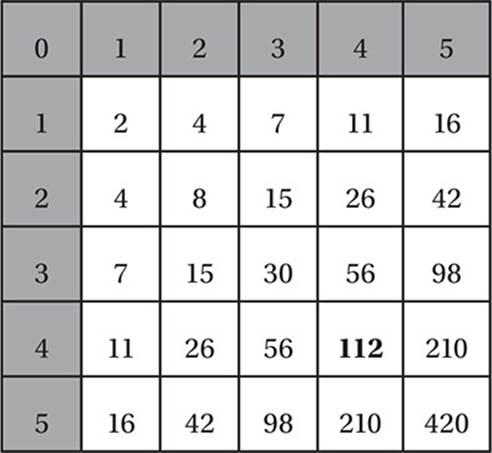
27. C
Advanced Mathematics (quadratics) HARD
We can find the value of c by just substituting x = –1 into the equation.
Given equation:
3x2 = 4x + c
Substitute x = –1:
3(–1)2 = 4(–1) + c
Simplify:
3 = –4 + c
Add 4:
7 = c
Therefore, the equation is:
3x2 = 4x + 7
Subtract 4x and 7:
3x2 – 4x – 7 = 0
Factor using Sum-Product Method:
(x + 1)(3x – 7) = 0
(Notice that the factor (x + 1) corresponds to the fact that x = –1 is a solution to the quadratic.)
Use Zero Product Property to find other solution:
3x − 7 = 0
Add 7:
3x = 7
Divide by 3:
x = 7/3
28. B
Special Topics (arcs) HARD
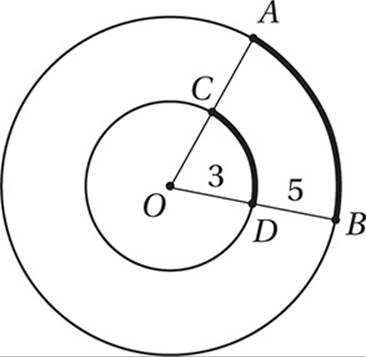
First, we should make sure we mark up the diagram with the measurements we know: OD = 3 and DB = 5. This means that the radius of the small circle is 3 and the radius of the large circle is 8. Notice that sectors AOB and COD share a central angle, and therefore are similar. So the measures of arc CD and arc AB are
in a ratio of 3:8.

Cross multiply:

Divide by 8:

29. C
Data Analysis (graphs) MEDIUM
Since there are only four data points, it’s not hard to list the February-May ordered pairs. Notice that the February axis is vertical, and the May axis is horizontal, so the typical x-y relationship is reversed:
Class A: February: 60, May: 60
Class B: February: 80, May: 70
Class C: February: 50, May: 70
Class D: February: 90, May: 90
Notice that the only class that saw an increase in percent participation is Class C.
30. C
Data Analysis (graphs) HARD
We just need to tally the number of students who participated from each class.
Class A: 60% of 20 students = 12 students
Class B: 70% of 30 students = 21 students
Class C: 70% of 20 students = 14 students
Class D: 90% of 30 students = 27 students
12 + 21 + 14 + 27 = 74 students
31. 0.8 or 4/5
Algebra (radical equations) EASY
Given equation:
![]()
Subtract 4:
![]()
Therefore, ![]() .
.
32. 8
Advance Mathematics (quadratics) EASY
Given equation:
y = 3x2 – kx – 35
Substitute x = 5 and y = 0:
0 = 3(5)2 – k(5) – 35
Simplify:
0 = 75 – 5k – 35
Simplify:
0 = 40 – 5k
Add 5k:
5k = 40
Divide by 5:
k = 8
33. .96
Additional Topics (circles/triangles) MEDIUM-HARD
When looking for the area of the triangle, remember that there are two basic methods: the direct method and the indirect method. With the direct method, we simply plug the base and height measurements into the formula  , and with the indirect method, we find the area as the sum or difference of other areas. In this case, since we know the lengths of one of the sides, the direct method is probably best. But we will need to find the height as well.
, and with the indirect method, we find the area as the sum or difference of other areas. In this case, since we know the lengths of one of the sides, the direct method is probably best. But we will need to find the height as well.
Area of the circle is π:
πr2 = π
Divide by π:
r2 = 1
Take square root:
r = 1
Now let’s mark up the diagram with this information. Since the radius of the circle is 1, the diameter FH has a length of 2. Now we can use the Pythagorean Theorem to find the length of GH, which is the height of the triangle if FG is taken as the base.
(1.6)2 + (GH)2 = 22
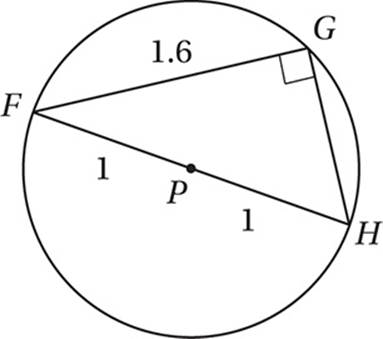
Simplify:
2.56 + (GH)2 = 4
Subtract 2.56:
(GH)2 = 1.44
Take square root:
GH = 1.2
(Notice that this is in fact a 3-4-5 triangle: if we multiply 3-4-5 by 0.4, we get 1.2-1.6-2.)
Plug into area formula:

34. 4.29 ≤ x ≤ 4.79
Algebra (solving inequalities) HARD

Multiply by –3 and “flip” inequalities:

Add 3:

Divide to get decimal form:
4.80 > 6t > 4.2857
Therefore any decimal value between 4.29 and 4.79, inclusive, is acceptable.
35. .84
Advanced Mathematics (trigonometry) MEDIUM-HARD
You may find it helpful to make a quick sketch of the unit circle on the xy-plane, as we discussed in Chapter 10. Subtracting π radians (or 180°) from an angle just means rotating the terminal ray of that angle 180° clockwise. It should be clear, then, that in the xy-plane, the angle with measure x – π points in the opposite direction of the angle with measure x. Recall that the cosine of an angle is just the x-coordinate of the point where its terminal ray intersects the unit circle. Since cos (x – π) = 0.4 (that is, its cosine is positive), its terminal ray must be in a quadrant where the x-coordinates are positive: either quadrant I or quadrant IV. Let’s just put it in quadrant I. This means that the angle with measure x is in quadrant III, and so it has the opposite cosine:
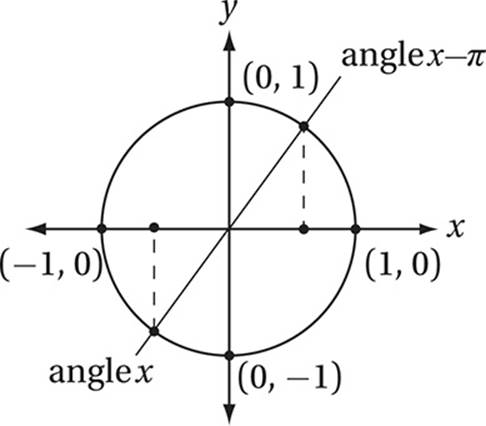
cos x = –0.4
Recall Pythagorean Identity from Chapter 10:
sin2 x + cos2 x = 1
Substitute cos x = 0.4:
sin2 x + (–0.4)2 = 1
Simplify:
sin2 x + 0.16 = 1
Subtract 0.16:
sin2 x = 0.84
36. 12
Problem Solving/Data Analysis (word problem) MEDIUM-HARD
This one is a bit trickier than it looks. We have 10 pounds of grain and have used it to feed 20 chickens. Since one pound of grain feeds 5 chickens, proportionally we need 4 pounds of grain to feed 20 chickens. This leaves us 10 − 4 = 6 pounds of grain to feed the pigs. Since 1 pound of grain can feed 2 pigs, proportionally 6 pounds of grain can feed 12 pigs.
37. 371
Problem Solving (extended thinking) HARD
The total revenue from the tickets sold is $60(50) + $50(60) + $40x + $35y + $30(100). If the total revenue was $15,000, then 3,000 + 3,000 + 40x + 35x + 3,000 = 15,000
Subtract 9,000:
40x + 35y = 6,000
Divide by 5:
8x + 7y = 1,200
If 15 more tickets were sold in the second mezzanine than the first mezzanine:
y = x + 15
Substitute y = x + 15 in previous equation:
8x + 7(x + 15) = 1,200
Distribute:
8x + 7x + 105 = 1,200
Subtract 105:
15x = 1,095
Divide by 15:
x = 73
Substitute to find y:
y = x + 15 = 73 + 15 = 88
Therefore, the total number of tickets sold is 50 + 60 + 73 + 88 + 100 = 371.
38. 25
Problem Solving (extended thinking) HARD
The mathematical model  has embedded in
has embedded in
it the predicted revenue per section: np = revenue per section = $2,800. Notice that this prediction is $200 less than the actual average revenue per section of $3,000, so clearly the model underestimated the number of tickets sold per section.
If we want to analyze this situation in detail, we can compare the predicted tickets sold to the actual tickets sold by adding a new column to the table entitled “predicted sold,” which we can fill in using the calculations from our model. Also, it might be helpful to also add columns for “total revenue” for each situation.
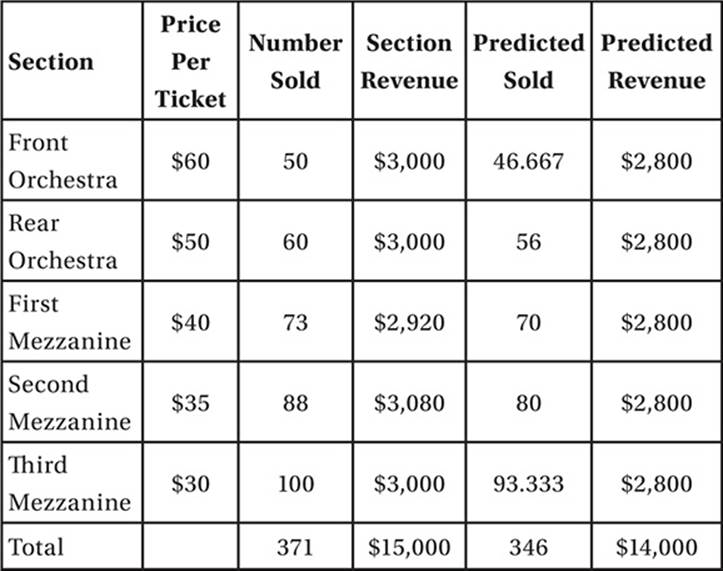
You might notice that the predicted number of tickets sold in the Front Orchestra and the Third Mezzanine are fractions, which seems strange. (Of course we can’t sell a fraction of a ticket!) But even if we round these predictions to the nearest whole numbers, 47 and 93, the total number of tickets is the same: 346, which underestimates the number of tickets sold by 25.
Section 5: Essay
Sample Response
Reading Score: 8 out of 8
Analysis Score: 8 out of 8
Writing Score: 8 out of 8
As Ellis Parker Butler sees it, American English spelling at the turn of the 20th century is a disaster. It defies logic and common sense, and it even destroys reason itself. Or so it seems. In fact, Butler’s essay is not so much about American English spelling rules as it is about American intellectual culture at the turn of the 20th century: it is inclined toward the petty and the self-important. In his essay, Butler builds his argument with humor and charm, and proposes tongue-in-cheek alternatives to traditional standards of, and more recent revisions to, American English spelling. In so doing he pokes ample fun at how Americans think and behave, delving into commentary on politics, technology, and cultural expectations. He uses metaphor, personification, anecdote, and sharp irony to skewer not only the American elite but also himself.
Butler begins his essay with mock-anger at “the spelling profession.” He claims it is “the reason America so long lagged behind Europe in the production of genius,” noting that, while Shakespeare (a Brit) was clearly a genius, Noah Webster (the American lexicographer) was less so. He mounts his high horse with indignant braggadocio: “. . . self-made authors like me, who never can spell but who simply blaze with genius, will be hooted out of the magazines to make room for a stupid sort of literature that is spelled correctly.” Butler’s juxtaposition of overconfidence and incompetence (at least in the arena of spelling) establish his wry and ironic tone, which he maintains consistently throughout the essay.
Butler then lashes the “spelling reformers” who want “this new phonetic spelling brought into use” for doing what “we Americans do not like,” namely, advocating for sudden change. He illustrates this cultural foible with the example of automobiles, “sixty horsepower snorters” that smell “like an eighteenth-century literary debate” that became acceptable because they were introduced gradually. In fact, Butler says, “we take to being killed by the automobile quite naturally now.” At this point, the reader is probably wondering if this essay is really about spelling after all.
Then he turns his gaze to the problem at hand: silent letters. But to Butler, unlike the “spelling reformers,” the problem is not practical but moral: we despise silent letters in our words because “we want no idle class in America, whether tramp, aristocrat, or silent letter.” His solution? To “set the idle letters to work.” Butler then announces that he, perhaps as a lone insurgent, will commence pronouncing them: “although” will now be a three-syllable word with an audible “ugh” at the end.
At this point, the reader probably recognizes Butler’s shift in topic to be a feint: in fact, the object of his satire is not spelling at all, but those who are obsessed with the idea of reform. The preposterousness of his theory is intended to reflect the preposterousness of those who spend so much time and mental energy on silly rules. His satire even extends to the peculiarly American obsession with committee meetings and reform projects: “I propose to have some millionaire endow my plan, and Serena (Butler’s wife) and I will then form a society for the reforming of English pronunciation.”
The greatest disadvantage of Butler’s plan, he admits, is that it is too commonsensical: it’s advantage is “so manifest that I am afraid it will never be adopted.” Here, we readers can’t help but wonder if Butler is making a wry commentary on bureaucratic incompetence in government and business.
Butler concludes by considering a “Plan B” offered by his wife, Serena: boycott words with silent letters. To Butler, this plan is less intellectual, but “more American”: “Why should people write ‘although’ when they can write ‘notwithstanding that,’ and not have a silent letter in it?” By calling Serena’s plan “more American,” he seems to be criticizing the fickleness of the American consumer, who will change habits sometimes for nonsensical reasons.
Butler uses ironic humor to skewer the American habit of arguing over silly things. By using himself as a foil, together with skillful use of metaphor, anecdote, and personification (“‘Although’ does all the work, and ‘ugh’ sits on the fence and whittles”), Butler encourages us to laugh at ourselves, and perhaps then move on to more serious matters.
Scoring
Reading—8 (both readers gave it a score of 4)
This response demonstrates thorough comprehension of Butler’s essay through skillful use of summary, paraphrases, and direct quotations. The author summarizes Butler’s central purpose and main idea (Butler’s essay is not so much about American English spelling rules as it is about American intellectual culture at the turn of the 20th century: it is inclined toward the petty and the self-important) and presents many details from the text, including abundant direct quotations. Each quotation is accompanied by insightful commentary that demonstrates that this author has thoroughly comprehended Butler’s central idea, as well as his skillful use of devices like irony, metaphor, and personification to support that claim.
Analysis—8 (both readers gave it a score of 4)
This response presents an insightful analysis of Butler’s essay and demonstrates a sophisticated understanding of the analytical task. This author has identified Butler’s primary modes of expression (metaphor, personification, anecdote, and sharp irony) and has uncovered the core message of the essay by exploring Butler’s use of these devices (he pokes ample fun at how Americans think and behave, delving into commentary on politics, technology, and cultural expectations). For example, the author identifies the devices that establish the essay’s overall tone (Butler’s juxtaposition of overconfidence and incompetence (at least in the arena of spelling) establish his wry and ironic tone, which he maintains consistently throughout the essay) as well as elements that establish layers of meaning (we readers can’t help but wonder if Butler is making a wry commentary on bureaucratic incompetence in government and business) and shift focus to more subtle ideas (the reader probably recognizes Butler’s shift in topic to be a feint: in fact, the object of his satire is not spelling at all, but those who are obsessed with the idea of reform). This response explores Butler’s essay systematically, from introduction to conclusion, with thoughtful commentary throughout.
Writing—8 (both readers gave it a score of 4)
This response shows a masterful use of language and sentence structure to establish a clear and insightful central claim (Butler’s essay is not so much about American English spelling rules as it is about American intellectual culture at the turn of the 20th century: it is inclined toward the petty and the self-important. . . . He uses metaphor, personification, anecdote, and sharp irony to skewer not only the American elite but also himself). The response maintains a consistent focus on this central claim, and supports it with a clear and deliberate analysis of Butler’s essay. The author shows particular skill in verb choice (defies logic . . . builds his argument . . . delving into commentary . . . establish his wry and ironic tone . . . lashes the “spelling reformers”), strength in using parallel structures (not only the American elite but also himself . . . while Shakespeare (a Brit) was clearly a genius, Noah Webster (the American lexicographer) was less so . . . the problem is not practical but moral), and thoughtfulness in diction and phrasing ([h]e mounts his high horse with indignant braggadocio . . . perhaps as a lone insurgent . . . perhaps as a lone insurgent . . . [h]is satire even extends to the peculiarly American obsession with committee meetings and reform projects). Largely free of grammatical error, this response demonstrates strong command of language and advanced proficiency in writing.